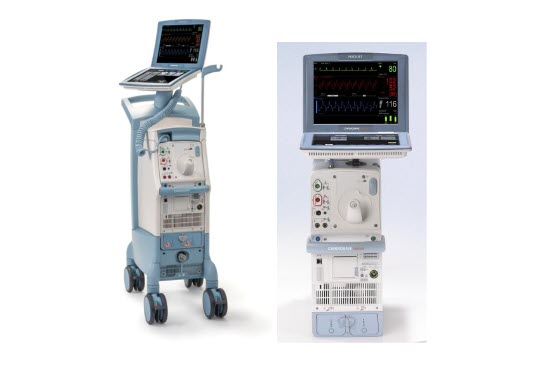Getinge/Maquet/Datascope Recalls Cardiosave Hybrid and Rescue Intra-aortic Balloon Pumps (IABPs) for Gas Loss and Gas Gain Failures
The FDA has identified this as a Class I recall, the most serious type of recall. Use of these devices may cause serious injuries or death.
The devices described in this recall are the same devices announced in the UPDATE: Risk of Device Failures for Getinge’s Maquet/Datascope Cardiosave Intra-Aortic Balloon Pump (IABP) – Letter to Health Care Providers on August 31, 2023.
Please be aware, this recall is a voluntary correction, not a product removal.
Recalled Product
- Product Names:
- Cardiosave Hybrid Intra-Aortic Balloon Pump (IABP) and Cardiosave Rescue Intra-Aortic Balloon Pump (IABP)
- Product Codes and Models:
- Distribution Dates: March 6, 2012 to May 19, 2023
- Devices Distributed in the U.S.: 4586
- Date Initiated by Firm: July 31, 2023
Device Use
The Cardiosave Hybrid and Rescue Intra-Aortic Balloon Pump (IABP) devices are electromechanical systems used to inflate and deflate intra-aortic balloons. These systems provide temporary support to the left ventricle through counter pulsation. Once the balloon is positioned in the aorta, the pump is set to work in synchrony with the electrocardiogram or arterial pressure waveform to make the balloon inflate and deflate at the right time during the cardiac cycle.
Cardiosave Intra-Aortic Balloon Pumps are indicated for acute coronary syndrome, cardiac and non-cardiac surgery, or complications of heart failure in adults. They are used in health care facilities.
Reason for Recall
Getinge/Maquet/Datascope is recalling their Cardiosave Hybrid and Rescue IABPs because the pumps may stop unexpectedly due to Gas Gain or Gas Loss alarms. The alarm will interrupt therapy and require user intervention to correct and restart. If the alarm persists, the device must be switched to a back-up IABP to continue therapy. If no back-up IABP is available, heath care professionals must seek an alternative way of providing hemodynamic support. This can include temporary use of vasopressors, inotropes, or other alternative therapies.
The alarm can be caused by patient movement (such as coughing, general movement, and swallowing); blood in the circuit; or loose connections, kinks, or abrasions to the tubing/catheter. Additionally, patients with fever or rapid heartbeat may experience a higher rate of gas loss, which can cause the alarm.
Interruptions in device therapy due to an affected pump may cause serious adverse health events, including unstable blood pressure, injury (for example: inadequate blood supply or a vital organ injury), and death.
Between January 1, 2021 and June 2, 2023, Getinge/Maquet/Datascope has reported 198 complaints related to this device issue, including three injuries and three devices involved in two patient deaths.
Who May be Affected
- People who receive circulatory support using a Cardiosave Hybrid or Rescue IABP
- Health care personnel providing care that includes the Cardiosave Hybrid or Rescue IABP
What to Do
On July 31, 2023, Getinge/Maquet/Datascope sent all affected customers an Urgent Medical Device Correction letter (described as “Issue 2: Gas Loss & Gas Gain Alarms”).
The letter requested customers to ensure patient movement is limited, to avoid possible tubing kinks and loose connections during IABP use, and to observe for and mitigate if there is blood in the circuit. If the alarms for “Gas Loss in IAB” or “Gas Gain in IAB” appear, the firm provides the following instructions for each alarm:
Gas Gain in IAB Circuit alarm:
- Verify all tubing connections are leak free.
- Press the START key to initiate an Autofill and resume pumping.
Gas Loss in IAB Circuit alarm:
- Inspect the tubing from the patient through to the connection of the helium extender tubing to the female luer port of the Cardiosave IABP.
- If any blood is noted or perforation is suspected, the following procedure must be performed immediately:
- Disconnect the catheter extender tubing from the IABP console to allow the balloon to deflate.
- Clamp extracorporeal tubing between white y-fitting and male connector.
- Place patient in Trendelenburg as tolerated to guide any residual helium to travel away from the head vessels.
- Notify physician and prepare for IAB catheter removal.
- Consider IAB catheter replacement if the patient’s condition warrants.
- If blood is suspected of having entered the pump, take pump out of service. It should be evaluated before use in another patient by a Getinge or Biomed/Technical Service representative who has been trained on Cardiosave service requirements, to determine if replacement of contaminated components is necessary.
- If blood is not detected, ensure that the IAB extender tubing is tightly connected to the IAB and the IABP. If appropriate, perform an Autofill by pressing and holding the IAB FILL key for 2 seconds, then press the START key to resume pumping.
- If the patient has a fever or rapid heartbeat, consider increasing the frequency of Autofills by initiating an Autofill prior to the regularly scheduled 2-hour Autofill.
If the user is unable to successfully troubleshoot the alarm, the healthcare provider will need to obtain a different IABP console to continue therapy. If another IABP console is not available for use, alternative means of providing hemodynamic support (vasopressors, inotropes, or alternate therapies) may be initiated by a healthcare provider as a temporizing measure.
Contact Information
Customers with questions about this recall should contact their Getinge/Maquet/Datascope representative or call Getinge/Maquet/Datascope Technical Support at 1-888-943-8872, options 4, 2, 1, Monday through Friday, between the hours of 8:00 a.m. and 6:00 p.m. (Eastern Time).
Additional Resources
- Medical Device Recalls database
- Letter to Health Care Provider
- Getinge/Maquet/Datascope - Urgent Medical Device Correction
How do I report a problem?
Health care professionals and consumers may report adverse reactions or quality problems they experienced using these devices to MedWatch: The FDA Safety Information and Adverse Event Reporting Program using an online form, regular mail, or FAX.

